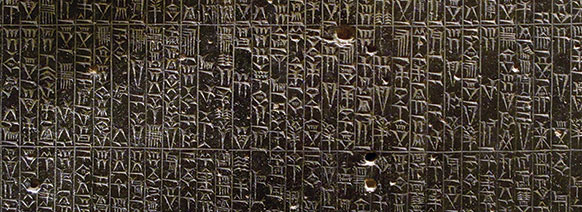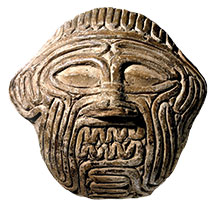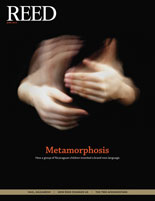
IRIS login | Reed College home Volume 92, No. 2: June 2013
Eliot Circular
Triumph of Gilgamesh

Consisting of 282 Babylonian laws inscribed on a stone stele and various clay tablets, Code of Hammurabi is among the oldest deciphered writings of significant length in the world.
By Randall S. Barton

Clay mask of the Huwawa, the monster defeated by Gilgamesh and Enkidu.
Achilles is in. Odysseus is out. And Hum 110 will have a new syllabus in the fall, beginning with two texts focused on Mesopotamia: the Code of Hammurabi and the Epic of Gilgamesh.
The revised syllabus recognizes the importance of the Greco-Roman experience in our intellectual heritage, according to professor Robert Knapp [English 1974–], but also explores some of the extraordinary civilizations that influenced the Greeks.
Consisting of 282 Babylonian laws inscribed on a stone stele and various clay tablets, Hammurabi is one of the oldest deciphered writings of significant length in the world, and was recovered by archeologists in 1901.
“The Code of Hammurabi provides some insight into the organization of one of humanity’s earliest, and most influential, complex, sedentary civilizations,” says professor David Garrett [history 1998–], who will deliver the lecture. “It introduces a central theme in the study of human society generally, the co-evolution of political authority and attempts to shape behavior through formal legal codes.” Hammurabi is no stranger to Hum 110—it was actually a mainstay of the syllabus in the early 1940s, when Reed’s foundational humanities course first took shape.
The Epic of Gilgamesh predates Homer by 1,500 years and is perhaps the oldest written story on earth. Discovered in 1853, it is a poem about a Sumerian king, Gilgamesh, who may have lived around 2500 BC in Mesopotamia.
In the last 50 years, says Knapp, scholarship has made it clear that the Greeks cannot be understood without considering the Mesopotamian influences on them.
“Nathalia King [English 1987–] was a very vigorous proponent of doing Gilgamesh,” Knapp says. “As she puts it, it is a poem that makes the case that in order to become human, one must accept being mortal. I don’t think there’s any doubt that Gilgamesh influences Homer.”
The late discovery of both texts precluded their ability to influence the Western tradition as it conceived of itself coming out of the Renaissance, Knapp says. But it is useful for students to consider the Babylonian, Persian, and Egyptian empires that predated the Greco-Roman civilization.
As to the return of the Iliad, the faculty reasoned that Gilgamesh talks more successfully to the Iliad than it does to the Odyssey. During the three-year trial period of the 2010 syllabus, the majority of them regretted losing the Iliad, which raises more complex issues than the Odyssey—a text many incoming students have already encountered in high school.
Knapp says one thing that distinguishes Reed’s humanities course is that the people who originally pulled it together were historians.
“You can see it in the details of the syllabus,” he says. “Yes, we read a number of texts that count as great books, enabling a kind of attention you can only give to texts that have that kind of density, which partly comes from comment on them. But it’s also a course that tries to be historical.”

LATEST COMMENTS
steve-jobs-1976 I knew Steve Jobs when he was on the second floor of Quincy. (Fall...
Utnapishtim - 2 weeks ago
Prof. Mason Drukman [political science 1964–70] This is gold, pure gold. God bless, Prof. Drukman.
puredog - 1 month ago
virginia-davis-1965 Such a good friend & compatriot in the day of Satyricon...
czarchasm - 4 months ago
John Peara Baba 1990 John died of a broken heart from losing his mom and then his...
kodachrome - 7 months ago
Carol Sawyer 1962 Who wrote this obit? I'm writing something about Carol Sawyer...
MsLaurie Pepper - 8 months ago
William W. Wissman MAT 1969 ...and THREE sisters. Sabra, the oldest, Mary, the middle, and...
riclf - 10 months ago